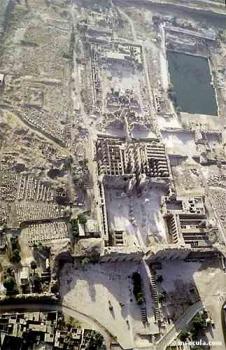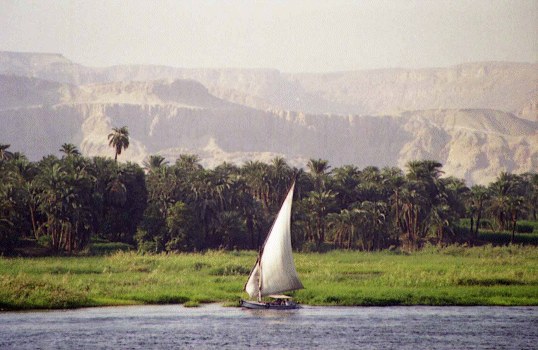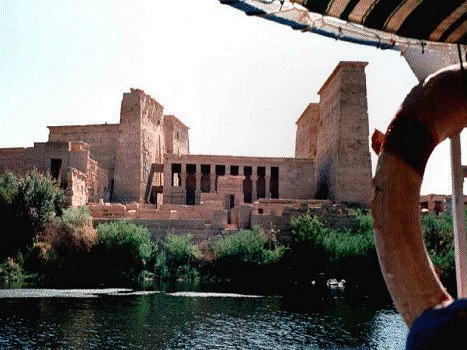 |
About three kilometres down the Nile, ancient Egyptians built the largest and most prosperous temple complex ever conceived by mankind: the Great Temple of Karnak. Known in Egypt as Ipet-isut, meaning 'Most Select of Places', it was built and enlarged over a period of thirteen hundred years. At the height of its power, papyrus inventories tell us it boasted 81,322 people, 420,000 head of cattle and 83 boats. It encompasses multiple sacred lakes, three large temples, several smaller chapels, and an entire complex of outer buildings.
|
 Naturally we would never ask such important personages as yourselves to walk three kilometres — unless, of course, you were performing sacred duties. So Pharaoh — may he enjoy life, health, and prosperity — has graciously provided four barges from his fleet to carry us to Karnak. If you will all step aboard, ours is the large blue and gold barge named The Victory of Amun. Is everyone ready? Then let's be off. Naturally we would never ask such important personages as yourselves to walk three kilometres — unless, of course, you were performing sacred duties. So Pharaoh — may he enjoy life, health, and prosperity — has graciously provided four barges from his fleet to carry us to Karnak. If you will all step aboard, ours is the large blue and gold barge named The Victory of Amun. Is everyone ready? Then let's be off.
 You might be interested to know that we are currently following in the footsteps of the God Amun. There are a number of festivals during the year, the most important of which is Opet celebrated at the New Year. At this time, statues representing the gods Amun, Mut, and Khonsu are taken in procession from Karnak to the Temple of Amun in Luxor. There they remain for three days, before being returned to their temples in Karnak. During the Divine Hatshepsut's reign, priests known a pure ones would walk to the Temple of Luxor carrying the statues in their sacred barques. The return to Karnak would be by way of the river. You might be interested to know that we are currently following in the footsteps of the God Amun. There are a number of festivals during the year, the most important of which is Opet celebrated at the New Year. At this time, statues representing the gods Amun, Mut, and Khonsu are taken in procession from Karnak to the Temple of Amun in Luxor. There they remain for three days, before being returned to their temples in Karnak. During the Divine Hatshepsut's reign, priests known a pure ones would walk to the Temple of Luxor carrying the statues in their sacred barques. The return to Karnak would be by way of the river.

 In addition to the festivals, Amun crosses the river once a week, where he visits the Eternal Temples of those Pharaohs who have gone to join with Osiris. On your left, you will see the west bank of the Nile and the famous Valley of the Kings. If you look closely, you can see the large pyramid shaped mountain that is the dwelling place of the goddess Meretseger, the protectoress of the Necropolis and patron of the artisans who create the divine Houses of Eternity. In addition to the festivals, Amun crosses the river once a week, where he visits the Eternal Temples of those Pharaohs who have gone to join with Osiris. On your left, you will see the west bank of the Nile and the famous Valley of the Kings. If you look closely, you can see the large pyramid shaped mountain that is the dwelling place of the goddess Meretseger, the protectoress of the Necropolis and patron of the artisans who create the divine Houses of Eternity.
 Ah! Here at last. If everyone will gather on the quay, before we enter the temple's gates I have a couple of announcements. Unfortunately there are several areas of the complex we will not be able to visit as they are being renovated. Then again, there is always construction going on at Karnak, so this is not surprising. And secondly I must warn you that the streets of the sacred precincts are a maze — difficult enough for natives to find their way; impossible for foreigners. Indeed, Pharaoh has ordered additional medjay to help track down and retrieve lost guests, but despite that we would suggest you don't stray from the tour. You could become hopelessly lost and would miss so much of your day in Waset. So come along with me, and I'll be your guide to the wonders of Karnak. Ah! Here at last. If everyone will gather on the quay, before we enter the temple's gates I have a couple of announcements. Unfortunately there are several areas of the complex we will not be able to visit as they are being renovated. Then again, there is always construction going on at Karnak, so this is not surprising. And secondly I must warn you that the streets of the sacred precincts are a maze — difficult enough for natives to find their way; impossible for foreigners. Indeed, Pharaoh has ordered additional medjay to help track down and retrieve lost guests, but despite that we would suggest you don't stray from the tour. You could become hopelessly lost and would miss so much of your day in Waset. So come along with me, and I'll be your guide to the wonders of Karnak.



|


![]() In addition to the festivals, Amun crosses the river once a week, where he visits the Eternal Temples of those Pharaohs who have gone to join with Osiris. On your left, you will see the west bank of the Nile and the famous Valley of the Kings. If you look closely, you can see the large pyramid shaped mountain that is the dwelling place of the goddess Meretseger, the protectoress of the Necropolis and patron of the artisans who create the divine Houses of Eternity.
In addition to the festivals, Amun crosses the river once a week, where he visits the Eternal Temples of those Pharaohs who have gone to join with Osiris. On your left, you will see the west bank of the Nile and the famous Valley of the Kings. If you look closely, you can see the large pyramid shaped mountain that is the dwelling place of the goddess Meretseger, the protectoress of the Necropolis and patron of the artisans who create the divine Houses of Eternity.
